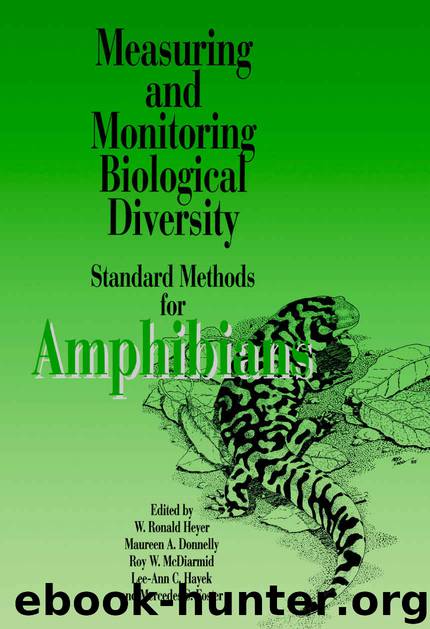Measuring and Monitoring Biological Diversity by Ronald Heyer

Author:Ronald Heyer
Language: eng
Format: azw3
ISBN: 9781588344373
Publisher: Smithsonian
Published: 2014-12-15T16:00:00+00:00
DATA TREATMENT AND INTERPRETATION
The type of data recorded and the analysis required will depend on the objectives of the study. Pertinent data for each sighting usually will include date, time, position, habitat, microhabitat, activity, and temperature (if temperature data are being transmitted). Environmental parameters should be recorded and include, where relevant: rainfall (past and current), air and water temperatures, wet bulb temperature, soil temperature, humidity, cloud cover, and moon phase. The establishment of a long-term weather station to record environmental variables, including maximum and minimum temperatures and rainfall, on a continuing basis would be advantageous (see Chapter 5).
If statistical procedures are to be used, they must be planned prior to the study to determine the amount and the type of data to be collected. A major problem with radio tracking is the low number of individuals that can be tracked at a given time. Statistical comparisons among individuals are difficult, and most studies to date have been descriptive, reporting patterns of movement and habitat use. White and Garrott (1990) provided a summary of statistical design and examples of statistical analyses suitable for radio tracking data that included tests for habitat preference and techniques to estimate survivorship and population size.
Download
This site does not store any files on its server. We only index and link to content provided by other sites. Please contact the content providers to delete copyright contents if any and email us, we'll remove relevant links or contents immediately.
Sapiens: A Brief History of Humankind by Yuval Noah Harari(13050)
The Tidewater Tales by John Barth(12029)
Do No Harm Stories of Life, Death and Brain Surgery by Henry Marsh(6336)
Mastermind: How to Think Like Sherlock Holmes by Maria Konnikova(6234)
The Thirst by Nesbo Jo(5785)
Why We Sleep: Unlocking the Power of Sleep and Dreams by Matthew Walker(5640)
Sapiens by Yuval Noah Harari(4534)
Life 3.0: Being Human in the Age of Artificial Intelligence by Tegmark Max(4505)
The Longevity Diet by Valter Longo(4445)
The Rules Do Not Apply by Ariel Levy(3905)
The Immortal Life of Henrietta Lacks by Rebecca Skloot(3826)
The Body: A Guide for Occupants by Bill Bryson(3799)
Why We Sleep by Matthew Walker(3771)
Animal Frequency by Melissa Alvarez(3754)
Yoga Anatomy by Kaminoff Leslie(3700)
Barron's AP Biology by Goldberg M.S. Deborah T(3631)
The Hacking of the American Mind by Robert H. Lustig(3579)
All Creatures Great and Small by James Herriot(3515)
Yoga Anatomy by Leslie Kaminoff & Amy Matthews(3394)
